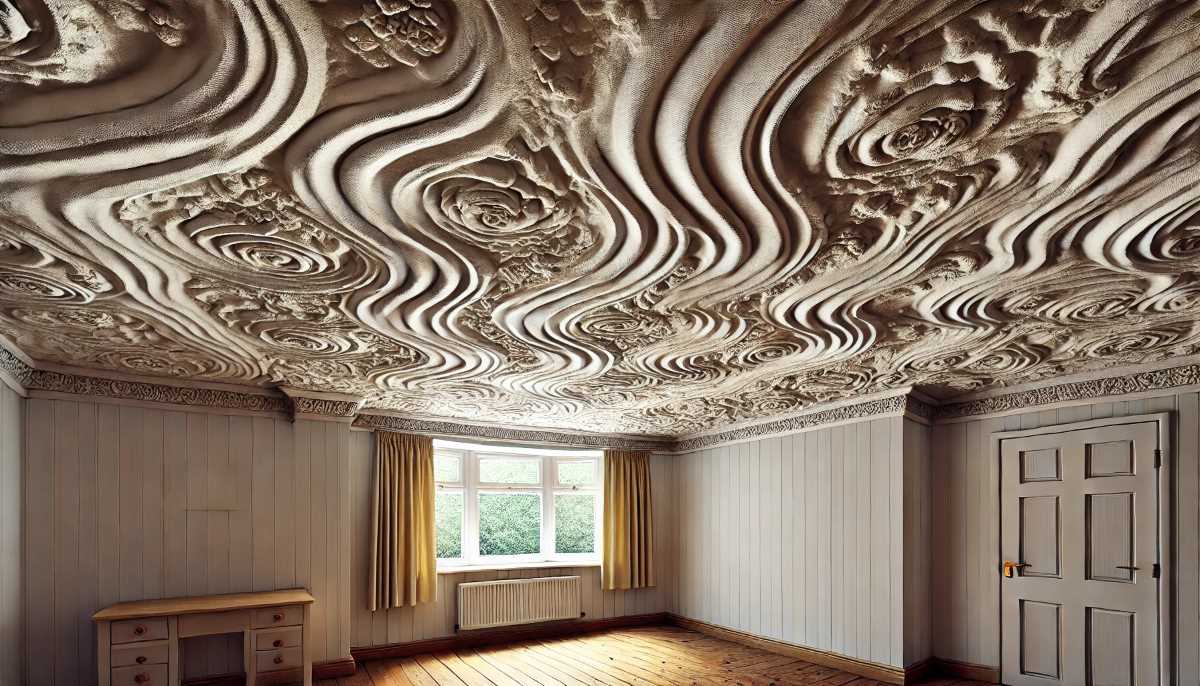Artex ceilings are everywhere. Of all the things we’ve inherited from the 1970s – disco, prawn cocktails, dysfunctional railway administration – Artex might be the most enduring.
Across the UK, you’ll find Artex, clinging to the ceilings like Gollum. Happy. Undisturbed. But now, as another generation (i.e. my one) has started to buy houses, we’ve been looking up, and noticing it.
And saying: what the hell is that, and what do I do with it?
What is Artex?
Artex is a type of plaster. It has a textured finish, which comes in a number of different patterns (listed here). Here’s one example, from our ceiling:

Artex became popular due to its ease of application. Normal plastering is hard. Getting that smooth finish is a highly skilled job, whereas the swirls and random scuffs of Artex are more accessible to the average DIYer. This is the main reason Artex was so popular from the 60s to the 90s: anyone could do it, and that made it a lot cheaper than proper plastering.
Artex is actually a brand name, made by Artex Ltd, based in Nottinghamshire. You can still buy it, if you like. Artex stands for Asbestos Reinforced Textured Coating.
Wait a minute…
Does Artex contain Asbestos?
Probably not. Artex stopped using asbestos as an ingredient in 1984. So if your Artex ceiling was created after 1984 then it probably doesn’t have asbestos in it. Although it might do, given it may have been stored for longer before sale. Or, of course, your textured ceiling might just be another brand of textured plaster.
Before 1984, Artex did often contain asbestos. It’s worth noting that this was the white variety of asbestos, which is less toxic than the green variety. And it was only in concentrations of 1-4%.
I appreciate that might not be very reassuring. Asbestos is very, very, very bad for you. Asbestos still contributes to about 5000 deaths a year in the UK (for comparison, prostate cancer kills around 12,000). But the reality is, if you leave Artex undisturbed, it’ll be fine. You can even still drill into it by spraying some water and capturing the dust.
And if you want to remove it, that’s fine too, just more expensive.
What should you do about your Artex?
Cards on the table: I like my Artex ceiling. But then, I think I’ve inherited a decent one. There are some real monsters out there.
So I’m going to leave mine. But if you don’t like it, what then? Well, here’s the fun bit. I’ve made an Artex decision flowchart to help make the choice:

To summarise, if you don’t like your Artex ceiling you can either:
- Cover it over with plaster (called ‘skimming’). This is fine if your Artex is Asbestos-free. If not, it may not be the most ethical approach, as anyone tearing it down in the future may be exposed to dangerous Asbestos which has been hidden by your additional layer. The chances are low, granted. If you are feeling super-ethical, you could of course skim it, then mention it to any subsequent buyer.
- Remove it entirely and redo the plastering. Obviously the more expensive option, and you’ll also want to get it professionally removed and disposed of if it does have Asbestos in it.
Will Artex affect house value?
Probably, yes. It’s impossible to get precise figures, but Artex is divisive, even when it’s done well. If it’s done badly, it’s very off-putting.
If you reduce the pool of possible buyers, on average your house value will drop. Less demand pushes prices down. And then there are the buyers who don’t mind it, but will be thinking about plastering over once they get in – they’ll be doing the sums in their head and taking that off their offer.
All this is common sense. But I was interested in the question: how many people actually like Artex? My unscientific survey took this thread where someone asked ‘should I keep this artex’ and counted the opinions.
| Artex Stance | People | Percentage |
| Like Artex | 39 | 61% |
| Hate Artex | 20 | 31% |
| Neutral | 5 | 8% |
In other words, 61% of people like Artex, and 31% of people don’t like Artex. And bear in mind that this is a discussion about a very nice example of Artex, and has probably attracted lots of fans of Artex as well, who have skewed the numbers.
If you have rubbish Artex, you’re going to be putting off more than a third of people from buying your house (!).
Type of Artex patterns
There are literally infinite ways to apply Artex. But, in reality, there’s four. These are:
- Stipple: lots of little dots, made by touching a texturing brush to the wet Artex. Fine.
- Swirl: turn the brush round. Make swirls. Quite horrible.
- Shells: made with a scraper comb and one clean motion. Variable.
- Broken Leather: made with a plastic bag over a brush. Honestly. People in the 70s and 80s were bagging their brushes, and sweeping them through wet asbestos to make it look like leather. There were only 3 TV channels, remember.

There you go, you are now a professional Artex-spotter.
How to repair Artex
Artex is notoriously difficult to repair. Especially the more chaotic varieties, such as broken leather. Let’s say you put a foot through the ceiling – how do you match the pattern when plaster the repair?
Well… with great difficulty and precision. There’s not a shortcut. Sorry. But people can do it, and I can recommend watching this Youtube video from Daniel Smith if you’re interested in the details.



